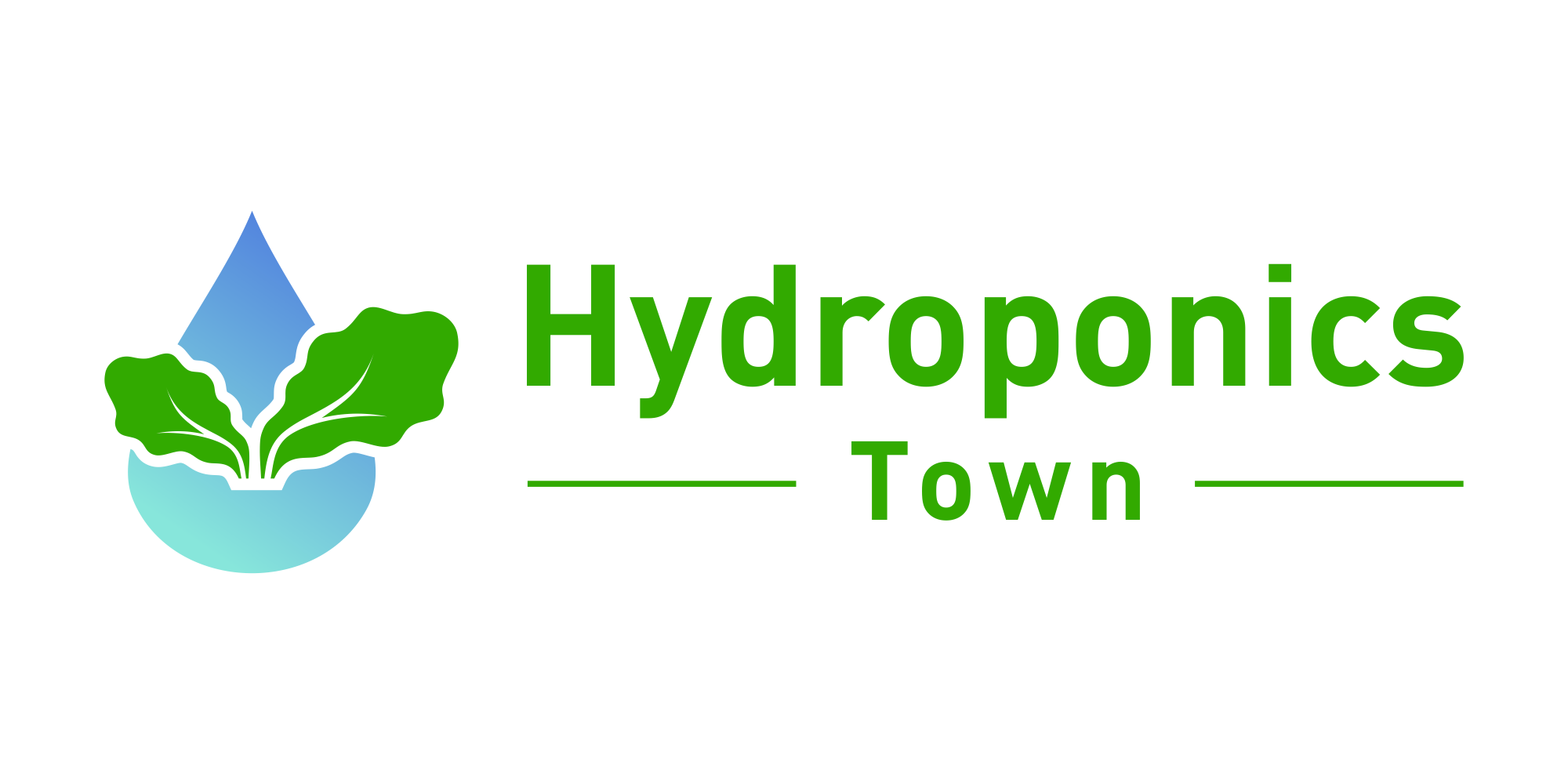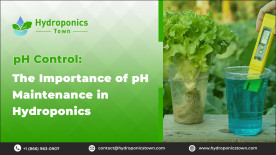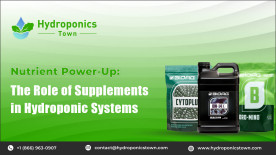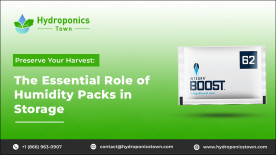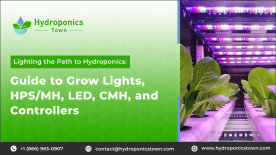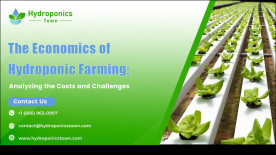Are you tired of struggling with traditional soil-based gardening methods? Want to grow plants faster, healthier, and more efficiently? Then get ready to dive into the world of hydroponic systems! In this article, we'll take you on an exciting journey through the Hydroponic System, where we'll explore everything you need to know about this revolutionary method of growing plants.
Whether you're a commercial farmer looking to boost your crop yields or a home gardener eager to grow fresh produce year-round, this guide is for you. Get ready to discover the secrets behind hydroponics and unlock a world of endless possibilities!
Table Of Contents: What Are the Benefits of Hydroponics? The Basic Components of a Hydroponic System. What Are the Different Types of Hydroponic Systems? |
What Is Hydroponics?
An innovative way to grow plants without using soil is through hydroponics. Instead, it entails cultivating plants in a solution of nutrient-rich water. With the help of this method, plants can get the vital minerals they need right to their roots in a controlled environment. Hydroponics utilizes various systems such as nutrient film technique, deep water culture, and aeroponics to support plant growth.
This innovative approach to gardening has gained popularity due to its ability to overcome space limitations, optimize resource utilization, and reduce the reliance on pesticides. Hydroponic farming enables year-round cultivation, making it suitable for urban areas, research facilities, and regions with unfavorable soil conditions.
Now that you know, what is hydroponics! Let us look at how it works.
How Does Hydroponics Work?
Hydroponic systems come in various forms, from DIY setups to commercial installations. The basic principle involves providing plants with water, nutrients, and oxygen directly to their roots.
In a DIY hydroponic system, plants are typically placed in a container filled with a growing medium like perlite or coconut coir. Nutrient-rich water is circulated to the roots using a pump, while an air stone provides oxygenation. This allows for efficient nutrient absorption and optimal plant growth.
Commercial hydroponic systems are more sophisticated and scalable, employing techniques such as nutrient film technique (NFT), deep water culture (DWC), or aeroponics. These systems provide precise control over nutrient levels, pH, and environmental factors to maximize crop yields.
What Are the Benefits of Hydroponics?
Here are some of the benefits of hydroponics systems:
Efficient resource utilization
The nutrients, water, and light that plants receive can all be precisely controlled using hydroponics. In order to minimize waste, plants only absorb the nutrients they require, allowing for the best possible resource utilization. Additionally, compared to conventional soil-based agriculture, hydroponic systems can use up to 90% less water, making them a very water-efficient technique.
Increased crop yields
In comparison to conventional soil cultivation, hydroponically grown plants frequently have faster growth rates and higher yields. This is due to the lack of need for extensive root systems since the plants always have access to the required nutrients. Hydroponic crops can produce more per unit area if the right nutrient balance and environmental factors are present.
If you’re looking to build a hydroponic garden,step-by-step-guide
Space efficiency
Hydroponics is particularly beneficial in areas with limited land availability. By growing plants vertically or in stacked systems, hydroponics maximizes space utilization. This makes it suitable for urban agriculture, rooftop gardens, or indoor farming, where space is a constraint.
Reduced dependency on pesticides and herbicides
In a controlled hydroponic environment, pests and diseases can be better managed. The absence of soil reduces the risk of soil-borne pathogens and pests, decreasing the reliance on chemical pesticides and herbicides. This can result in cleaner, healthier produce and a reduced environmental impact.
Year-round cultivation
Hydroponics allows for year-round cultivation irrespective of seasonal limitations. Indoor hydroponic systems can provide optimal growing conditions regardless of external weather conditions. This ensures a continuous supply of fresh produce throughout the year, reducing dependency on seasonal variations.
Despite the numerous hydroponics benefits, they also have the downside. Here are the disadvantages:
Initial setup cost
The initial investment required to set up a hydroponic system can be higher compared to traditional soil-based farming. The cost includes infrastructure, equipment, lighting, and nutrient solutions. However, the long-term benefits and potential for increased yields can offset the initial expenses.
Technical knowledge and maintenance
Hydroponics involves a more complex setup and requires technical knowledge to ensure proper nutrient balance, pH levels, and environmental conditions. Regular monitoring and maintenance are essential to prevent issues such as nutrient deficiencies, algae growth, or system failures.
Power dependency
Indoor hydroponic systems rely on artificial lighting, heating, and cooling systems, which can significantly increase electricity consumption. This dependency on electricity adds to the operational costs and carbon footprint, although advancements in energy-efficient technologies are helping to mitigate this drawback.
Limited crop variety
While hydroponics is suitable for a wide range of leafy greens, herbs, and certain fruiting crops, it may not be ideal for all types of plants. Crops with extensive root systems or those that rely on beneficial soil microorganisms may not thrive in hydroponic environments.
The Basic Components of a Hydroponic System
To maintain a thriving hydroponic system, you need to understand the key components that ensure its efficient operation. These hydroponic parts includes:
Growing Media
Growing media serves as a substitute for soil in hydroponics. It supports the plant's weight and root structure, while retaining moisture and nutrients from the nutrient solution. The media does not provide independent nutrition to the plants and is often pH-neutral, ensuring a balanced nutrient solution. Various options are available, and the choice depends on the specific plant and hydroponic system.
Air Stones and Air pumps
Air stones and air pumps are crucial for oxygenating the water in which the plants are submerged. The air stones disperse tiny bubbles of dissolved oxygen, preventing the plants from drowning and helping distribute nutrients evenly. Air stones should be connected to an external air pump using opaque food-grade plastic tubing to prevent algae growth.
Net pods
Net pots are mesh planters that hold the hydroponic plants. They allow the roots to grow out of the sides and bottom, providing increased exposure to oxygen and nutrients. Net pots also offer superior drainage compared to traditional clay or plastic pots.
What Are the Different Types of Hydroponic Systems?
There are various types of hydroponic systems, each with its own unique characteristics and benefits. Here are the six different types of hydroponic systems:
Deep Water Culture Systems (DWC)
One of the simplest hydroponic systems is a deep water culture system, also known as a DWC system or a raft system. This technique involves suspending plants in a nutrient-rich solution while allowing their roots to touch the water directly. Typically, Styrofoam floating rafts are used to hold the plants upright while allowing their roots to reach the water. Air stones or diffusers are used to deliver oxygen to the roots. DWC systems are inexpensive, simple to set up, and effective for growing herbs and leafy greens.
Wick Systems
In wick systems, the roots of the plants are placed in a growing medium, such as perlite or vermiculite. The nutrient solution is contained in a reservoir that is connected to the growing medium by a wick, which is typically made of cotton or nylon. The nutrient solution is drawn up by the wick and delivered to the roots. Wick systems are a passive hydroponic technique that don't need electricity or pumps to work. They might not be appropriate for larger plants or crops with high nutrient and water requirements, though.
Nutrient Film Technique Systems (NFT)
Systems using the nutrient film technique, or NFT systems, continuously spray a thin layer of nutrient solution over the roots of the plants. A thin film of nutrient solution is flowing through the channel or trough in which the roots are kept. A continuous circulation is created by pumping the nutrient solution from a reservoir to the highest end of the channel and then letting it flow back to the reservoir. As they are exposed to the air in the channel, the roots take in oxygen from it. Crops with shallow root systems, such as lettuce, herbs, and strawberries, are frequently grown using NFT systems.
Ebb and Flow Systems
Flood and drain systems, also referred to as ebb and flow systems, function by periodically flooding the plant roots with nutrient solution and then draining it away. Containers containing a growing medium, such as perlite or coconut coir, are used to grow the plants. The nutrient solution is flooded into the containers using a pump, and after that, it is allowed to drain back into a reservoir. A timer is typically used to automate this flooding and draining cycle. With their adaptability, ebb and flow systems can be used to grow a variety of plants, from tiny herbs to bigger fruiting plants.
Drip Systems
By way of a network of drip emitters, drip systems, as the name implies, deliver nutrient solution directly to the roots of the plants. Typically, a pump is used to deliver the nutrient solution to the plants, which are housed in containers that are filled with a growing medium. In order to provide a consistent supply of water and nutrients, the nutrient solution is drip-applied to the soil or directly to the roots. Hydroponic growers favor drip systems because they can be automated and work well with a variety of crops.
Aeroponics
In a high-tech hydroponic system known as aeroponics, plants are grown in an environment of air or mist without the use of a growing medium. The roots of the plants are suspended in the air and are periodically sprayed with a nutrient-rich mist. This mist encourages rapid growth and effective absorption by directly supplying nutrients and water to the roots. Misters, foggers, or high-pressure sprayers are frequently used in aeroponics systems to deliver nutrient solutions. The roots are open to the air, allowing for maximum nutrient and oxygen absorption. This technique encourages quicker plant growth and is very effective. To maintain ideal moisture levels and nutrient delivery, aeroponic systems need more specialized tools and close observation.
Common Problems and Solutions of Hydroponics
Plants can be grown hydroponically without soil—it's a soil-free, efficient method that maximizes crop yield. As with any agricultural practice, hydroponics can face certain problems that need to be addressed for successful plant growth. Here are some common problems encountered in hydroponics and their potential solutions.
Seedling Problems
One of the initial challenges in hydroponics is ensuring successful germination and healthy seedling development. Some common seedling problems include damping-off, slow growth, and weak stems. These issues can arise due to excessive moisture, poor air circulation, or fungal and bacterial infections.
Solution:
Use clean, high-quality seeds and sterile growing media to minimize the risk of pathogens.
Maintain proper air circulation and ventilation in the growing area to prevent excessive humidity.
Avoid overwatering by monitoring and adjusting the irrigation system to provide adequate but not excessive moisture.
Incorporate beneficial microorganisms or fungicides into the hydroponic system to suppress harmful pathogens.
System Clogging Problem
Hydroponic systems rely on the flow of nutrient solution through various channels, pipes, and drip lines. Sometimes, these systems can experience clogging, hindering the delivery of water and nutrients to the plants. Clogs can occur due to sediment buildup, root intrusion, or debris accumulation.
Solution:
Regularly inspect and clean the system components to prevent debris accumulation. This includes filters, drip lines, and pumps.
Use appropriate filters to remove sediment and debris from the nutrient solution.
Employ root barriers, such as screens or mesh, to prevent roots from entering and clogging the system.
Consider using non-clogging substrates or materials that minimize the risk of blockages.
Infestation Problem
Pests and diseases can pose significant challenges in hydroponics, as the controlled environment can create favorable conditions for their growth. Common pests in hydroponics include aphids, mites, whiteflies, and fungus gnats.
Solution:
Implement strict hygiene practices, including regular cleaning and disinfection of the growing area and equipment.
Monitor the plants regularly for signs of pests or diseases and take appropriate action at the first indication.
Introduce biological control agents, such as predatory insects or beneficial nematodes, to combat pests.
Use insecticidal soaps, oils, or organic pesticides as a last resort if other methods are ineffective.
Nutrient Deficiencies
In hydroponics, plants rely on nutrient solutions for their growth and development. However, imbalances or deficiencies in essential nutrients can occur, affecting plant health and productivity. Common nutrient deficiencies include nitrogen, phosphorus, potassium, iron, and calcium deficiencies.
Solution:
Regularly monitor the nutrient levels in the solution using appropriate testing methods.
Adjust the nutrient solution formulation according to the specific requirements of the plants being grown.
Provide a balanced nutrient solution by incorporating a wide range of essential elements.
Consider using chelated nutrients or foliar sprays to address specific nutrient deficiencies quickly.
How to Grow Hydroponic Plants?
Here are the basic steps on how to grow hydroponic plants:
Choose a hydroponic system: There are many different types of hydroponic systems available, so choose one that is right for your needs and space.
Prepare the system: This may involve cleaning the system, adding nutrients, and adjusting the pH level of the water.
Plant your seeds or seedlings: Follow the instructions on the seed packet or seedling tray.
Provide light and water: Hydroponic plants need plenty of light and water to grow.
Fertilize your plants: Hydroponic plants need nutrients to grow, so fertilize them regularly.
Monitor your plants: Keep an eye on your plants for signs of problems, such as pests or diseases.
With a little care and attention, you can grow healthy and productive hydroponic plants.
Look at these 13 Best Plants for Hydroponics in 2023
Here are some additional tips for growing hydroponic plants:
Use clean water: Hydroponic plants are sensitive to contaminants in the water, so use filtered or distilled water.
Add nutrients regularly: Hydroponic plants need a steady supply of nutrients to grow, so add nutrients to the water according to the manufacturer's instructions.
Monitor the pH level: The pH level of the water is important for plant growth, so monitor it regularly and adjust it as needed.
Provide adequate light: Hydroponic plants need at least 12 hours of light per day.
Control pests and diseases: Hydroponic plants are susceptible to pests and diseases, so inspect them regularly and take steps to control any problems.
Hydroponic systems offer a sustainable and efficient method of cultivation that can revolutionize traditional farming practices. With precise control over nutrient delivery and environmental conditions, hydroponics maximizes yields while minimizing water usage and land requirements. Whether for small-scale home gardening or large-scale commercial production, hydroponics presents a promising solution for the future of agriculture, ensuring food security and environmental sustainability.
FAQs
What is the best location for hydroponics?
The best location for hydroponics is a place that gets plenty of sunlight and has access to water. A greenhouse is a good option, as it provides protection from the elements.
What is the main problem in hydroponics?
The main problem in hydroponics is the risk of nutrient imbalance. The plants may suffer if the nutrient solution is improperly balanced.
What climate is best for hydroponics?
Hydroponics can be grown in any climate, but it is most successful in warm, sunny climates.
Are hydroponic plants healthy to eat?
Yes, hydroponic plants are healthy to eat. In fact, they may be even healthier than plants grown in soil. This is because hydroponic plants are not exposed to pesticides or herbicides, and they are grown in a controlled environment that is free of pests and diseases.
How much does a hydroponic setup cost in the USA?
The price of a hydroponic system varies according to the system's size and complexity. While a large-scale commercial system can cost tens of thousands of dollars, a basic system for a small home garden can be purchased for as little as $100.
